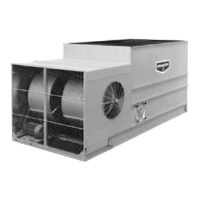10
Operation and Maintenance Instructions
Direct drive fan units do not require any adjustment (4' Wide Induced Draft ICT Models Only).
Fan System — Capacity Control
There are several methods for capacity control of the evaporative cooling unit. Methods include: Fan motor cycling, the use of two
speed motors and the use of variable frequency drives (VFDʼs). In all cases, if motors are idle for extended periods of time with
water still being directed over heat transfer media, motor space heaters are suggested.
Fan Motor Cycling
Fan Motor Cycling requires the use of a single stage thermostat which senses the water temperature. The contacts of the
thermostat are wired in series with the fan motorʼs starter holding coil.
Fan Motor Cycling is often found to be inadequate where the load has a wide fluctuation. In this method, there are only two stable
levels of performance: 100% of capacity when the fan is on and approximately 10% of capacity when the fan is off. Please note,
rapid cycling of the fan motors can cause the fan motor to overheat. Controls should be set to only allow a maximum of six (6)
start/stop cycles per hour.
Two Speed Motors
The use of a two speed motor provides an additional step of capacity control when used with the fan cycling method. The low
speed of the motor will provide 60% of full speed capacity.
Two speed capacity control systems require not only a two speed motor, but a two stage thermostat and the proper two speed
motor starter. The most common two speed motor is a single winding type. This is also known as a consequent pole design. Two
speed two winding motors are also available. All multi-speed motors used in evaporative cooling units should be variable torque
design.
It is important to note that when two speed motors are to be used, the motor starter controls must be equipped with a decelerating
time delay relay. The time delay should be a minimum of a 30 second delay when switching from high speed to low speed.
Figure 6 – LPT Motor Adjustment

